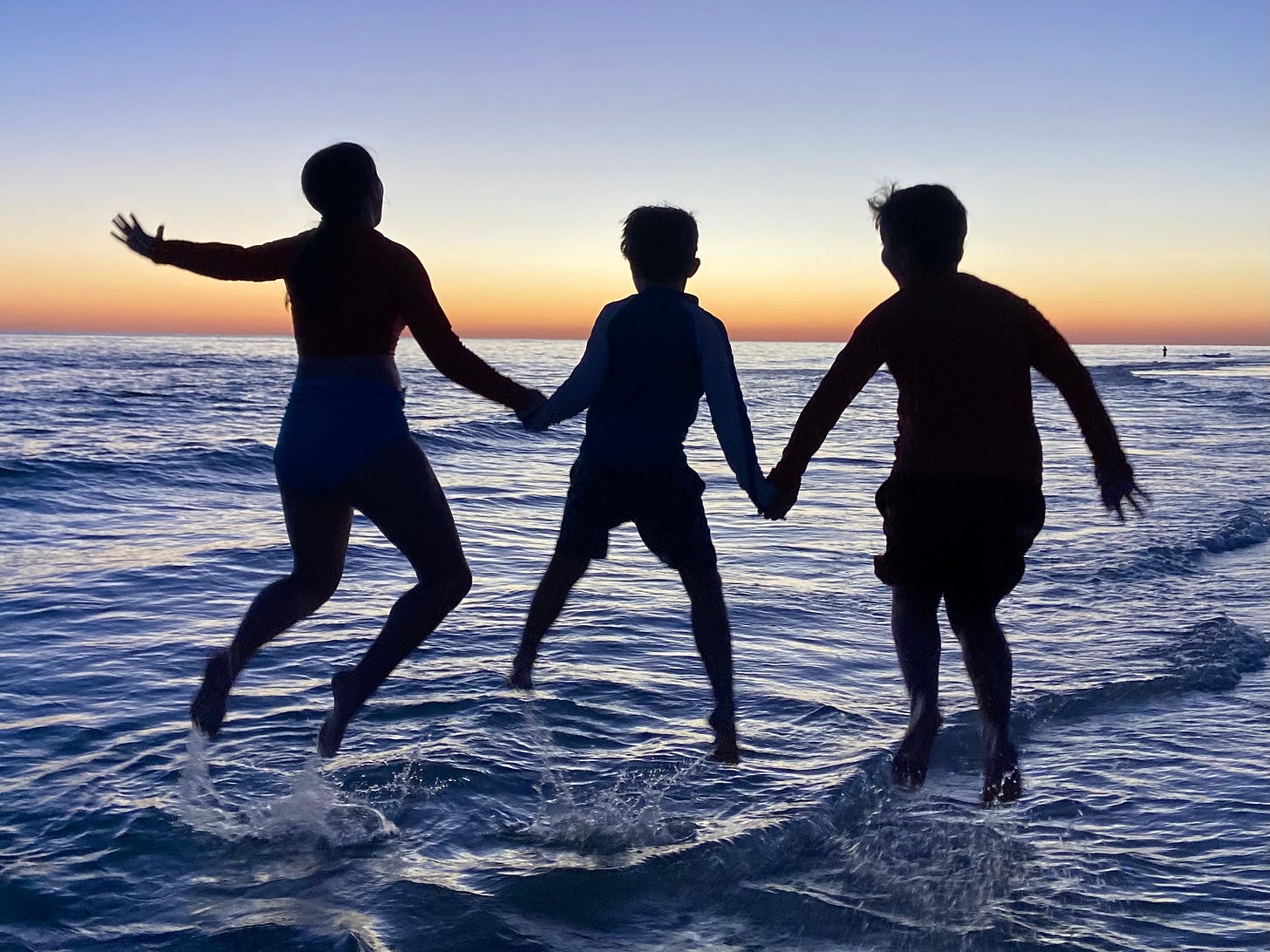My Summer Sur-THRIVE-al Guide || Part 1
I'm not promising it will be perfect, but it could be intentional.
In my writing life, I’m not much of a how-to gal. I’m more the occasional nudger who says, “Hey, you might want to check this out,” without promising to step-by-step you into bliss. That’s just not me.
Occasionally, though, the way I go about doing something sometimes works well enough that I think it might be worth sharing. And one of those things, I believe, is summer break with school-aged kids.
But it wasn’t always that way.
Not even two weeks into the the summer of 2018, I made desperate pleas for counselor recommendations to anyone who would listen. Our daughter had just finished up kindergarten, our middle, his first year of preschool, and there was a nursing two-year old and 34 years of my issues to grapple with — all at home together. After a few years of prioritizing everything but, I needed help to make sense of why it all felt so painfully difficult.
Through the slow start of healing, I learned to lead myself and them better.1

In case you’re new around here: our three kids are now elementary and middle school-aged. We live in a suburban area in the southern United States and I’m a homeschooling (one out of three, now) stay-at-home mother. There’s no one-size-fits-all summer, so don’t please don’t for one second think that’s what I’m about to say here.
This week, our youngest finishes school at home and tutorial. Our middle child wraps up next Monday and our oldest takes her last final exam on Friday. It being the bigs’ first year back in a traditional school setting since they came home in March 2020, this summer’s transition is the most significant we’ve experienced since 2019. All the more necessary to allow space to settle in after a season so new.
I’m grateful that summer doesn’t daunt me the way that it used to. Somewhere between therapy and trying, I found a way to some sort of rhythm where everything feels possible while tempering expectation. Now that we’re quickly approaching its full-fledged arrival, I thought I might offer some insight.
And while we’re at it, I want to hear how YOU make summer work for you!
Three words work.
Before summer break even starts, I’m asking these three questions.
What does our family need most to reset this summer?
What do I want this season to be remembered for?
What can I do to build a better bridge to the next school year?
I try to make each answer only one word. If I can hang on to just these three words — whether adjective, verb, or noun — it keeps things simple. This year, my answers are: Rest, Adventure, Reading
For you, they could be anything as practical or as abstract as your family needs.
Peace, Connection, Independence / Quiet, Play, Responsibility / Space, Laughter, Math.
The sky’s the limit here, but the purpose is to recognize that your summer holds opportunity, not just obligation. It’s not a time to just get through, and you can, if you want to, make meaning out of it — even small steps at a time.
Begin with the forest, not the trees.
Let’s look at the BIG PICTURE.
Because I’ve been doing this awhile, my summer planning starts sometime in late winter when I take a gander at the twelve-ish weeks we usually have to work with. Hear me say, though: it’s not too late to start now.
On a sheet of paper, I create a numbered list for every week we have that includes the date of each Monday through summer. On each week I jot down keywords for anything already on the docket for that week: camps, travel, birthdays, holidays, etc. This helps me see the pacing of our summer, and this list goes at the top of a Note (titled “Summa-Summa-Summa-Summatime ☀️ ” — thank you DJ Jazzy Jeff and Will Smith) which I’ve kept on my phone for years now, updating with each year’s changes.2
As spring rolls along, the list gets adjusted accordingly and I also start to collect information from our library, city, and county’s websites for fun (free!) events or activities planned for the summer.
Say it with me now because we will be repeating this: it’s good to have options.
Each year, it feels like we do less, letting a couple of busy weeks be followed by one or more of less busy. I recognize that as a stay-at-home mom who is not working in any capacity outside of the home, I have the freedom to consider this. You may need something different, and by all means, please do what serves you and your family best.
Either way you slice it, looking at the big picture is the way to fill (or to purposefully not fill) the time we get with our kids at home.3 When you see the forest from above, it’s maybe a little less likely you’ll get lost in the woods along your way.
Help everyone catch the vision.
In the last couple of weeks of the school year, I print monthly calendars for May, June, July, and August (the school years around here typically run mid-August to mid-May). The style linked above is the one I’ve used the last few years, but there are many other options available on their site: May, June, July, August.
To these calendars, I transcribe anything already scheduled (each person with their own color!) so it’s very obvious to everyone where we do (and don’t) have space for the whole summer. These sheets live on the chalkboard4 in our dining room (you could use the inside of your pantry or coat closet) so that no one can tell me they don’t know what’s going on.
Looking at these, I ask them to imagine their best summer. We’ve never done a bucket list, but I know people who love to do them. We’ve done themed days and weeks long ago in the past, but they didn’t always work for us. Each of my kids’ answers to what their best summer would be are some shade of different than the other and don’t always align with what I’m desiring for them (Minecraft! All day!), but we all have a part to play in constructing our summer. I’m not a cruise director, here, and I think they like having input.
Hanging these up all together in one spot has helped my kids catch the vision for the opportunity that lies before them. They take increasingly more ownership for their activities (while I’m still driving them places) and feel less pressure that the next school year is waiting just around the bend. By the end of summer, they get to see the evidence of the richness of our days.
That often makes it easier to welcome the next season, knowing each has its gifts.
Next week I’ll be back with a few more — dare I say practical? — bits and bobs of other ways I’ve learned to make summer break work for us (and not the other way around).
I’ve by no means figured this all out, though, and I know in a few years we’ll enter a new phase with summer employment and higher stakes. Many of you reading know far better than I, and I really do want to hear what rhythms you’ve found to find that thriving sweet spot in your summers.
Until next week,
And am still healing and learning, I should add.
Y’all know I love an analog life but this Note (and the weekend plans one my husband and I share) are worth their weight in gold. Not having to reinvent the wheel, making simple updates, and having the information accessible has saved me SO MANY TIMES. I’ve also been able to easily copy and share with local friends looking for info and ideas. My version of switching to analog for this might look like updating it on my laptop and printing it off at the start of each summer and pasting it into my pocket notebook… but we’ll see about that.
Or if they ARE home all the time because you homeschool and you don’t homeschool year round — getting to take a step back from the formal teaching/learning part.
This is in addition to the normal wall calendar that lives in our back entry all year.









I kind of love that you plan to have rest and adventure co-exist :)
I love all the hard work you did